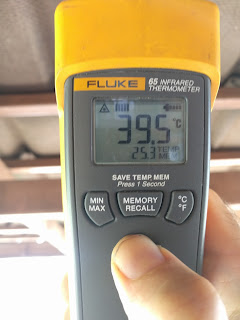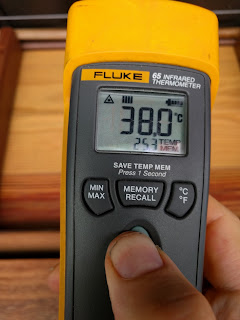We are past the Songkran holidays here in Bangkok now and the weather is really getting quite hot. The good news is that the low thermal mass design principals we’ve gone for have been very successful in releasing the heat of the day quickly at night allowing the house to be cool enough to sleep comfortably at night without any air conditioning or other active cooling.
But during the day, it gets very very hot.
We have been working on ways to get sprinklers up on the roof to use our excess of filtered reclaimed water to help cool down the roof during the day, but today I was pondering the effects of the solar panels as a double roof, basically shading the actual roof from the sun.
We currently have 4 solar panels on the south facing balcony roof although the roof is big enough for (and we built the rack to handle) up to 12.
As a result, in the center of the balcony roof, the roof is shaded by the solar panels. But to the side, the roof is directly exposed to the sun.
The question I wanted to answer was “how much of a difference does this make?”
The answer appears to be “quite a bit of difference”.
The temperature of the under side of the roof where the solar panels are shading it is around 39.5 degrees Celsius (103F):
This is quite hot by itself.
But when I move to the side of the roof where the solar panels are not shading them, the temperature goes up dramatically to 60.3 Celsius (141F):
This is a big difference.
On the northern balcony, as an artifact of how the architect designed the house, there is a substantial overlap between the main house roof and the balcony roof:
And comparing the shaded and unshaded temperatures of the balcony (lower) roof yields very similar results.
The shaded area is about 38C (100F):
But the unshaded roof is around 60C (140F):
For comparison to ambient temperature, the floor is about 34.5C (94C):
In summary, while the shaded areas of the roof are only about 3.5C higher than the ambient (floor) temperature, the unshaded areas are about 24.5C higher.
This is enough of a difference to begin asking how to add a double roof.
(Side note, we experimented a few months ago with putting reflective insulation under the roof. It was quite effective temperature-wise, but rats started making a nest between insulation and roof and chewing up both insulation and roof. So we took the insulation down. If we can find a way to glue the insulation to the roof with no space between for vermin, then this would hopefully achieve the same results.)







I've been looking into similar ideas in Manila. Thanks for posting.
There's a really good article on double roofs here http://www.houstoncoolmetalroofs.com/cool-roof-information/cool-roof-design-texas/
and one question I asked them was about using solar panels to double roof. One disadvantage of solar panels is that they aren't designed to cover the entire roof. Another is that they are hard to make typhoon proof. But double roofing seems a great idea, and so are solar panels, so can they be put together somehow?